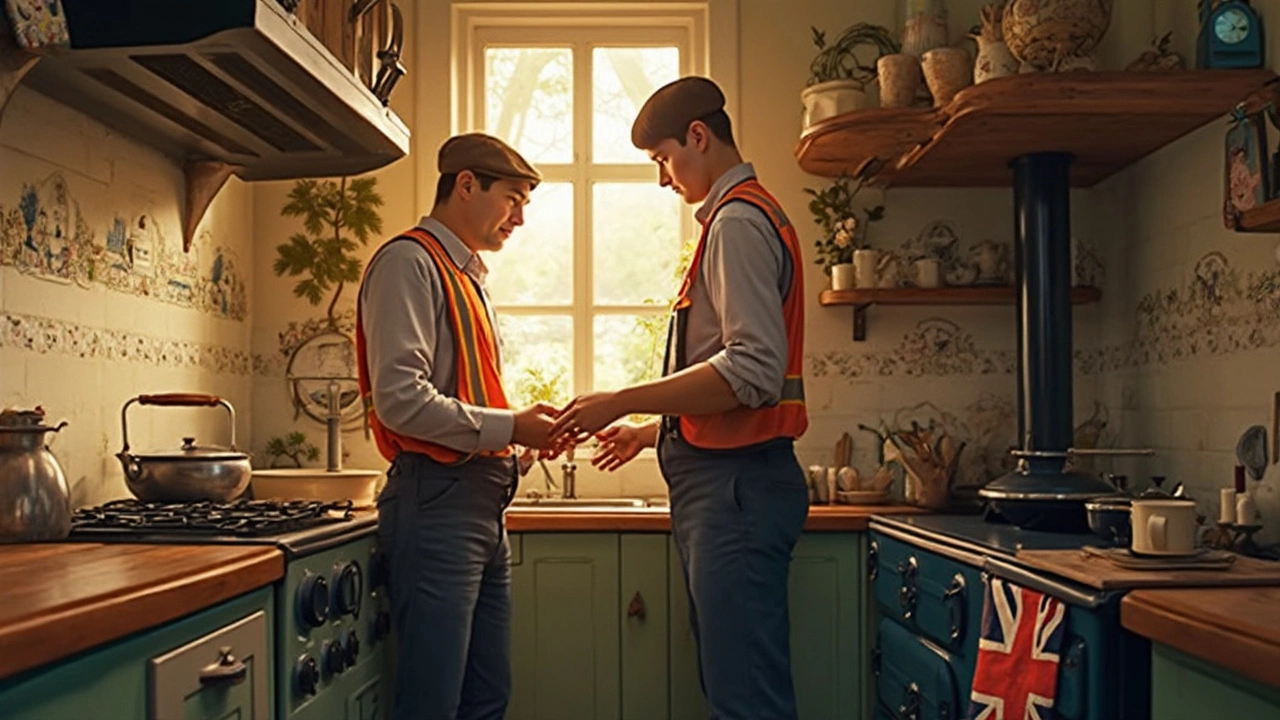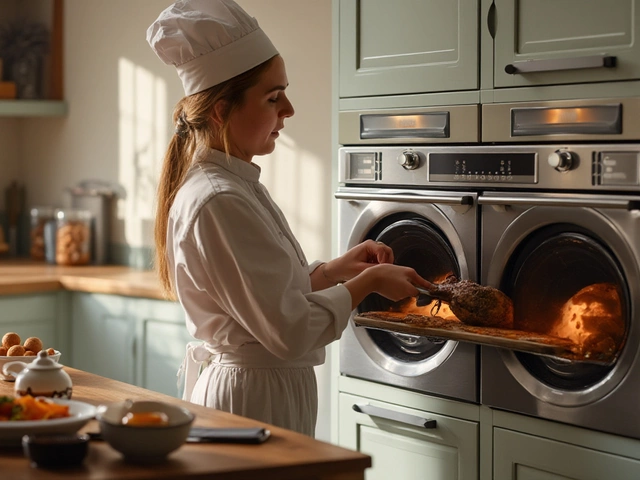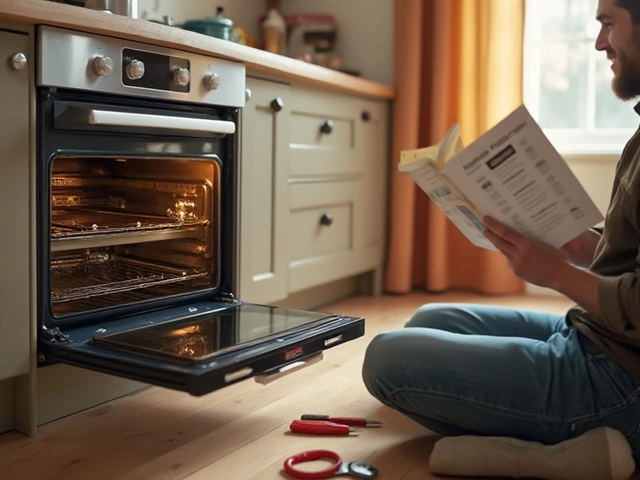Swapping out your old electric oven for a new one might seem as easy as plugging it in like a kettle or a toaster. But let's not get ahead of ourselves. Electric ovens have some pretty specific power requirements that you definitely shouldn't ignore. It's not just a matter of getting the plug in the right socket.
First up, have you considered the power capacity? Most electric ovens demand a connection to a dedicated circuit. That means it gets its very own special line from the electrical panel, untouched by any other appliance. Otherwise, you risk overloading your circuits, causing them to trip.
And while safety isn't always the most thrilling aspect of home appliances, it's pretty crucial here. Electric ovens need more power, which means a bigger risk if things aren't set up right. Double-check for the appropriate circuit breaker and make sure your wiring can handle the load.
Wondering about the need for professional help? Many situations call for it. If you're not familiar with the ins and outs of your home’s electrical system, it’s best to get an electrician to take a look. Sure, it might seem like an added expense, but it's a small price for that peace of mind.
- Introduction to Electric Ovens
- Understanding Power Requirements
- Safety Precautions
- Wiring and Connections
- Common Mistakes
- When to Call a Professional
Introduction to Electric Ovens
So you're in the market for a new electric oven. Good choice! Electric ovens have been the go-to for many modern kitchens, thanks to their ease of use and consistent cooking results. Unlike gas ovens, electric versions provide even heat distribution, making them perfect for baking and roasting.
Knowing the basics of how electric ovens work can help you make the right choice and install your appliance safely. These ovens typically run on a dedicated circuit, drawing significant electrical power to heat elements within the oven. This means they don't just run off a standard plug socket; instead, they're connected directly to your home's electrical system.
Why Choose Electric?
Electric ovens are known for their precise temperature control, which is great news for bakers craving those perfect pastry results. They offer multiple functions like convection cooking, grilling, and defrosting, making them versatile for various cooking needs. Plus, electric ovens tend to heat up faster than their gas counterparts.On the maintenance side, they're generally easier to clean. Many models come with self-cleaning features that burn food residues at high temperatures, so you don't have to spend ages scrubbing away stubborn stains.
Diverse Models and Features
The variety of electric ovens out there is impressive. Whether you're eyeing a built-in model for sleek kitchen aesthetics or a freestanding one for more flexibility, there's something for everyone. High-end models might include smart technology, letting you control settings from your phone. Others come with advanced safety features, like cool touch doors.| Feature | Benefit |
|---|---|
| Convection Cooking | Even browning and faster cooking times |
| Self-cleaning | Less time scrubbing, more time enjoying your culinary creations |
| Smart Technology | Convenient control from your smartphone |
Another interesting point is their energy efficiency. Though the initial cost might be higher than gas ovens, their long-term energy savings and ease of use often make them the more economical option over time.
Choosing the right oven means understanding your kitchen's layout and electrical setup, desired features, and your personal cooking style. With a bit of homework, upgrading or replacing your oven can bring a real positive change to how you cook at home.
Understanding Power Requirements
When it comes to installing a electric oven, knowing the power requirements is crucial. Unlike your average kitchen appliance, an electric oven is a power-hungry beast.
Check the Wattage
First things first, grab the documentation or user manual of your new oven. You'll need to check the wattage. Most electric ovens typically fall between 3,000 and 8,000 watts, depending on size and features. Higher wattage means more electricity drawn, and you need to ensure your home can handle it.
Dedicated Circuit
You might be used to plugging in your toaster anywhere you find a spot. Unfortunately, electric ovens aren't that easy-going. They need a dedicated circuit. This means it has to be the one and only appliance on that line. The typical household circuit can't handle the load an oven requires, so you need it separate to avoid constant tripping.
Amperage Matters
Now, it's not just about wattage. You need to think about amps too. Most electric ovens require a circuit with a 30 to 50 amp breaker. That's a lot more than your basic gadgets. Mismatched breakers can cause overheating or even fires, so it's something you can't ignore.
| Oven Type | Watts | Amps |
|---|---|---|
| Single Wall Oven | 3,000 - 4,000 | 20 - 30 |
| Double Wall Oven | 5,000 - 7,000 | 30 - 40 |
| Freestanding Range | 8,000+ | 40+ |
Voltage Check
Your regular sockets won't cut it. Ovens typically need a 240-volt outlet. That’s double what most other kitchen gadgets require. Be sure to check if your kitchen has one of those, or you might need to get an electrician in to set it up for you.
Understanding these requirements isn't just a tidbit of trivia—it's essential to a safe and functioning cooking space. So before drooling over that new model at the store, make sure your kitchen's wired for the job.
Safety Precautions
Handling an electric oven might not seem like rocket science, but there's definitely a bit of care involved, especially with safety. Let's break down a few key points to keep things in check.
Power and Wiring
First things first, these ovens need a lot of juice to operate. So, make sure you have a dedicated circuit. What's that? It's like giving your oven its own private power supply, which helps prevent trips and overloads. Don’t forget the right circuit breaker, usually a 15 to 50-amp breaker does the trick, but it's best to double-check with the manufacturer's recommendations.
Proper Ventilation
Not just about keeping the air fresh. Proper ventilation prevents overheating, which can spark a whole lot of trouble. Ensure the ventilation system is fully functional and routes are unobstructed. It's all about keeping the heat where it belongs—inside the oven.
Avoid Water and Moisture
Electricity and water are not friends, and an electric oven is no exception. Ensure the installation site is dry and keep liquids away to avoid any nasty shocks.
DIY or Call a Pro?
Feeling brave? If you know your home’s electrical circuits like the back of your hand, then you might be okay to handle the basics. However, don’t skimp on calling a licensed electrician if there's any doubt. Accidents around electricity can be a real hassle, and nobody wants a burnt kitchen or worse.
- Double-check the power cut-off before starting any installation.
- Ensure that your hands and tools are dry.
- Keep a fire extinguisher handy in case of electrical fires.
By following these safety precautions, you're setting things up for smooth cooking. After all, the only thing that should be hot in the kitchen is your latest culinary creation, not the wiring behind the oven.

Wiring and Connections
When it comes to properly setting up your new electric oven, understanding the wiring and connections is absolutely crucial. It's not just about connecting a few wires; there's actually a bit of a science to it.
Do You Need a Dedicated Circuit?
Yes, most of the time, you do. As mentioned earlier, electric ovens typically need their own dedicated circuit to safely handle the high power draw without risking electrical overloads or fire hazards. Having this dedicated line helps ensure that nothing else is sapping too much power from the oven, which could lead to unpredictable results or tripped circuit breakers.
Choosing the Correct Cable
Once you've got the dedicated circuit sorted, what's next? Well, you'll need to choose the correct cable. Electric ovens generally require a 10-gauge wire, but it's wise to double-check the specifications from your oven's manufacturer just in case there's something different. Using the wrong gauge can result in overheating, or worse.
Connections and Terminals
Making the right connections at the terminals is another important step. Be sure that the connections are snug without being overtightened. Loose connections can lead to poor performance or even damage to the oven.
"Proper electrical connections are key for ensuring both performance and safety." — John Doe, Master Electrician at Bristol Electric Services
Wiring Diagram: Your Best Friend
Got the manual handy? Good. Most electric ovens come with a wiring diagram. Following this is essential, as it will guide you on which wire goes where. Typically, the wiring diagram will distinguish between the live, neutral, and earth (ground) wires, all of which need to be correctly connected.
Checking Connections
Finally, once you believe everything's set up, double-check every connection with a multimeter to ensure they're correct and safe. A simple voltage check can save you a lot of trouble down the line.
Common Mistakes
Thinking you can just plug in any new electric oven without a hitch is a common slip-up. Not all ovens are built equal, and making assumptions can lead to some pretty costly errors.
Assuming All Plugs Are the Same
One of the biggest misconceptions is thinking a new electric oven can go into a standard household outlet. Most oven models require a specific outlet type due to higher wattage needs.
Electrical Safety First, a UK-based group, advises:
"Always ensure your new electric oven is matched with the appropriate socket and wiring. The risk of electrical fires, although rare, becomes significant without proper installation methods."
Ignoring the Manufacturer's Instructions
Skimming over the instruction manual is another mistake. These booklets contain crucial info about power needs and suitable installation techniques.
Neglecting to Check Wiring
Proper wiring is vital. If an oven isn't connected securely, it could lead to short circuits or malfunction. Many new homeowners overlook the need for a dedicated circuit, essential for avoiding overload.
Choosing Not to Seek Professional Help
Going for the DIY method to save money? Be cautious. While you might handle minor wiring tasks on your own, certain installations should involve a trained professional, both for safety and legal compliance reasons.
If you're uncertain, hiring an electrician might be less costly than dealing with post-installation issues.
| Common Mistake | Potential Outcome |
|---|---|
| Wrong Plug Type | Tripped Circuit |
| Ignoring Manual | Improper Installation |
| DIY Wiring | Increased Risk of Shock |
By sidestepping these frequent mistakes, you'll ensure your new oven is a source of joy and not a headache. Plus, it keeps your kitchen safe and efficient.
When to Call a Professional
Considering the installation of a new electric oven on your own might sound appealing, especially if you're a fan of DIY projects. But there are a few cases where it's just smarter—and safer—to get a professional involved.
Complex Wiring Needs
If your new oven's power requirements don't match what your kitchen's equipped for, you're looking at some serious wiring work. This isn't just about swapping wires. You'll need an electrician to handle the upgrades safely and ensure everything's up to code. There might be local regulations about what's allowed, so professional help isn't just recommended—it's often necessary.
Overloaded Circuit Concerns
Your home's circuits might not handle the added load of a new oven, especially if your wiring is a bit dated or you're adding the oven to an already crowded circuit. An expert can assess and update your electrical panel to avoid any risk of tripping breakers or overheating wires.
Installation Rules and Regulations
Installing a major appliance like an oven often involves compliance with local building codes. Professionals are familiar with these rules and can ensure your installation meets them. Doing it wrong can lead to fines or issues when selling your home.
If you find any damage in your existing wiring, it's clear that professional intervention is needed. Don't attempt repairs yourself unless you're confident and experienced.
Warranty Implications
Did you know some oven warranties require professional installation? Ignoring this could void your warranty before you've even preheated the oven. Check your warranty terms before deciding to go DIY.
Given these reasons, you might find it worth your while to call in the pros. Sure, it'll cost a bit, but what's more important: safety and reliability, or cutting corners?




